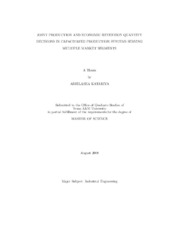| dc.contributor.advisor | Tekin, Eylem | |
| dc.creator | Katariya, Abhilasha Prakash | |
| dc.date.accessioned | 2010-01-15T00:11:37Z | |
| dc.date.accessioned | 2010-01-16T01:10:20Z | |
| dc.date.available | 2010-01-15T00:11:37Z | |
| dc.date.available | 2010-01-16T01:10:20Z | |
| dc.date.created | 2008-08 | |
| dc.date.issued | 2009-05-15 | |
| dc.identifier.uri | https://hdl.handle.net/1969.1/ETD-TAMU-2985 | |
| dc.description.abstract | In this research, we consider production/inventory management decisions of a rmthat sells its product in two market segments during a nite planning horizon. In thebeginning of each period, the rm makes a decision on how much to produce basedon the production capacity and the current on-hand inventory available. After theproduction is made at the beginning of the period, the rm rst satises the stochasticdemand from customers in its primary market. Any primary market demand thatcannot be satised is lost. After satisfying the demand from the primary market, ifthere is still inventory on hand, all or part of the remaining products can be sold ina secondary market with ample demand at a lower price. Hence, the second decisionthat the rm makes in each period is how much to sell in the secondary market, orequivalently, how much inventory to carry to the next period.The objective is to maximize the expected net revenue during a nite planninghorizon by determining the optimal production quantity in each period, and theoptimal inventory amount to carry to the next period after the sales in primary andsecondary markets. We term the optimal inventory amount to be carried to the nextperiod as \economic retention quantity". We model this problem as a nite horizonstochastic dynamic program. Our focus is to characterize the structure of the optimalpolicy and to analyze the system under dierent parameter settings. Conditioning on given parameter set, we establish lower and upper bounds on the optimal policyparameters. Furthermore, we provide computational tools to determine the optimalpolicy parameters. Results of the numerical analysis are used to provide furtherinsights into the problem from a managerial perspective. | en |
| dc.format.medium | electronic | en |
| dc.format.mimetype | application/pdf | |
| dc.language.iso | en_US | |
| dc.subject | stochastic demand | en |
| dc.subject | capacity constraint system | en |
| dc.subject | production/inventory systems | en |
| dc.subject | disposal | en |
| dc.subject | ordering | en |
| dc.title | Joint production and economic retention quantity decisions in capacitated production systems serving multiple market segments | en |
| dc.type | Book | en |
| dc.type | Thesis | en |
| thesis.degree.department | Industrial and Systems Engineering | en |
| thesis.degree.discipline | Industrial Engineering | en |
| thesis.degree.grantor | Texas A&M University | en |
| thesis.degree.name | Master of Science | en |
| thesis.degree.level | Masters | en |
| dc.contributor.committeeMember | Daripa, Prabir | |
| dc.contributor.committeeMember | Wilhelm, Wilbert | |
| dc.type.genre | Electronic Thesis | en |
| dc.type.material | text | en |
| dc.format.digitalOrigin | born digital | en |


